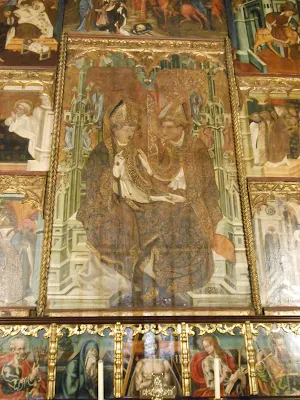I am currently in Barcelona, and chose today to visit the cathedral, jointly dedicated to the Holy Cross and St Eulalia, a local martyr of the persecution of Diocletian. I did not know ahead of time that today is the anniversary of its dedication, the same day as the dedication of the Roman basilicas of St Peter in the Vatican and
St Paul Outside-the-Walls, and also as that of
the cathedral of Siena. The church seems to have a pretty strong liturgical life going, at least in terms of the number of Masses being said (in both Spanish and Catalan), a good number of regular devotions, and the availability of Confession. The building is a very interesting mix of the Gothic, from its original construction and decoration from the 13th to 15th centuries, with a number of Baroque additions; here are just a few photos of a complex far too rich in art and history to fully capture in a photoessay like this.
 |
| The crypt under the high altar, where the relics of St Eulalia repose. |
 |
| The vaulting of the apse, seen from the stairs that lead down to the crypt. |
 |
| The vaults of the nave, seen from the same point, |
 |
| The tombs of Count Ramon Berenguer I (left), founder of the Romanesque cathedral which was later replaced by the current Gothic building, and his third wife, Almodis de la Marche (right). |
 |
| The upper part of the liturgical choir, which is badly lit and hard to photograph. |
 |
| The organ |
 |
| The altarpiece of the chapel of Ss Ambrose and Martin, by Joan Matas, 1415 |
 |
| The altarpiece of Ss Clare and Catherine of Alexandria, by Miquel Nadal and Pere Garcia de Benavarri, 1454-58 |
 |
| An altarpiece commemorating the founding of the Mercedarian Order, which took place in the city of Barcelona in 1218; by Joan Ruig, 1688. |
 |
| In the Gothic cloister, 13 white geese are kept; they are traditionally said to be the same number as the age of St Eulalia at the time of her martyrdom. |
 |
| A view of the famous Sagrada Familia from the roof of the cathedral. |
 |
| The principal spire of the church, completed in the 19th century. |
 |
| The spire seen from inside. |













